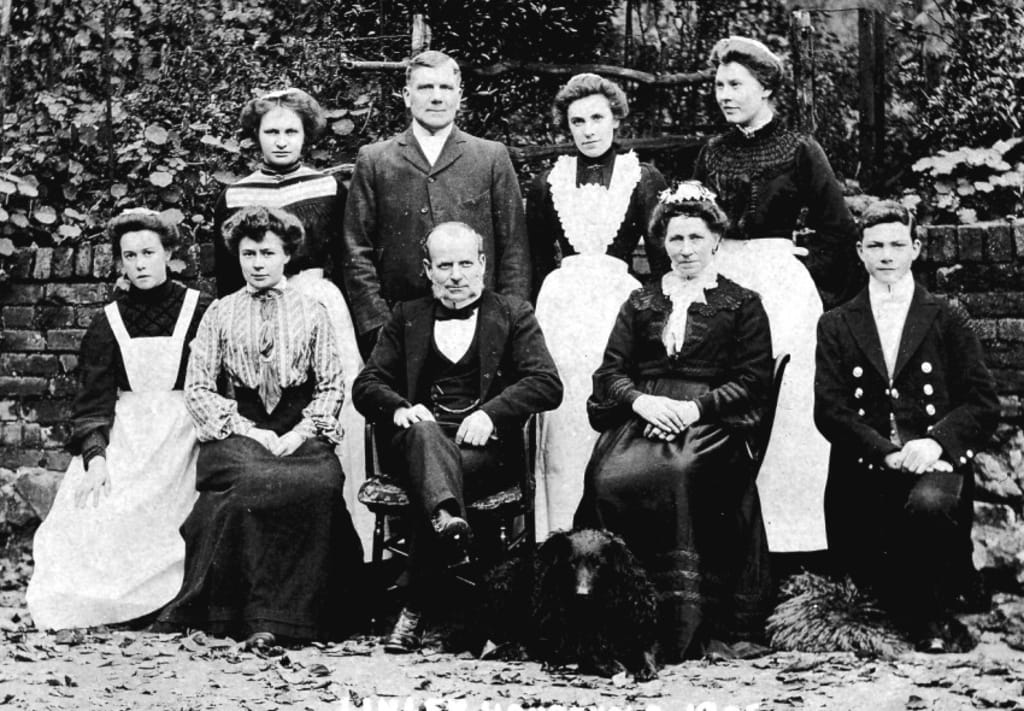SERVANTS IN THE EDWARDIAN ERA
PART ONE

Many of us have seen “Upstairs Downstairs,” “Gosford Park” and, more recently, “Downton Abbey,” and do we not ‘wonder’ at how life was back then, in the Edwardian Era. To be a Servant or “In Service” was looked at as a decent job, with a possibility of promotion (after many years), especially if you worked “in the big house.” My own grandmother was a maid in service before getting married, and the photo of her in her maid’ uniform, is quite an heirloom. I remember her trying to teach me ‘Silver Service’ (serving in the dining room) and how ‘strange’ it all seemed to me personally.
In this Era, one and a half million British people worked as servants = 1 in 4 were employed as a domestic servant. Often, these servants were given a new name whilst in service: “That is not a servant’s name, you will be called Sarah” says the Lady of the House. Jimmy became James (Downton Abbey) for as long as he was a footman in that house.
Being ‘in service’ was a welcomed opportunity (even if you did have to change your name) as the alternative was often stifling poverty and even starvation. You may have been required to “live in” with one half day off a month (if you were lucky), but you slept in a bed, under a roof and has two good meal a day. The hours were long = 12-14 hrs. a day = depending on your ‘job’, and the pay wasn’t brilliant, but it was better than walking the streets, starving. It was a lot more comfortable to be domestic service.

This was not easy employment. Whether you were a housekeeper (at the top of the female chain) or a hall boy (at the bottom of the male chain), you were at the beck and call of the Master and Mistress every hour of the day. While ‘them upstairs’ dined on the finest of foods, often having 9-course meals, with the best china and cutlery, the servants ‘downstairs’ often used “Servants china and cutlery” and, sometimes, were allowed to eat the left-overs from ‘upstairs dinner,’ or they had very basic but nourishing food. The Upper Classes (them upstairs) had a full calendar of visiting, The London Season and shooting, whereas the servants worked around the clock with one day off a month (if they were lucky). We just cannot imagine working like this today!
As mentioned before, being ‘in service’ was preferred to over living in the slums. The 1901 census tells us that 1,690,686 servants were women = 40.5% of the adult female working population. From the age of 12 / 13, young girls were sent out to work, to live in a strange house with strangers, and only contacting home through letter writing. A maid was always in demand, as back then, there were none of the labour-saving appliances we take for granted today (for example, hoover, fridge, dish water). It seemed that people were brought up to be in domestic service back then.
It was preferred to work for a High Lord and Lady (i.e. Lord Grantham --- Downton Abbey) as the elevated social position of the employer meant the servants automatically gained respect from the locals, which included tradesmen and shop workers. Even ‘downstairs’, there was a strict hierarchy and every servant was expected to know his / her place.

“The staff quarters and the family quarters were separated by a large door that was often covered in green baize. Each servant knew exactly which rooms they were allowed to clean and work in and when. Very few servants strayed.” Even though the female servants outnumbered the male servants, life below stairs was still a male-dominated hierarchy with the butler or the menservants were given greater authority, thus higher pay, then the housekeeper.
A little different when compared with today’s generation, I couldn’t blame anyone going into “Service” in the Edwardian Era. At least you had a roof over your head, a bed to sleep in, two good meals a day and pay. Yes, the hours and work were long and hard but worth it when compared to the poverty and starvation back then.
Look out for Part Two = coming very soon!
About the Creator
Ruth Elizabeth Stiff
I love all things Earthy and Self-Help
History is one of my favourite subjects and I love to write short fiction
Research is so interesting for me too






Comments
There are no comments for this story
Be the first to respond and start the conversation.